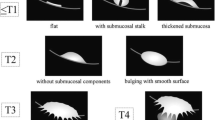Abstract
Objects
To investigate the utility of fused high b value diffusion-weighted imaging (DWI) and T2-weighted imaging (T2WI) for evaluating depth of invasion in bladder cancer.
Methods
We included 62 patients with magnetic resonance imaging (MRI) and surgically confirmed urothelial carcinoma in the urinary bladder. An experienced genitourinary radiologist analysed the depth of invasion (T stage <2 or ≥2) using T2WI, DWI, T2WI plus DWI, and fused DWI and T2WI (fusion MRI). Sensitivity, specificity, positive predictive value (PPV), negative predictive value (NPV) and accuracy were investigated. Area under the curve (AUC) was analysed to identify T stage ≥2.
Results
The rate of patients with surgically confirmed T stage ≥2 was 41.9% (26/62). Sensitivity, specificity, PPV, NPV and accuracy were 50.0%, 55.6%, 44.8%, 60.6% and 53.2%, respectively, with T2WI; 57.7%, 77.8%, 65.2%, 71.8% and 69.4%, respectively, with DWI; 65.4%, 80.6%, 70.8%, 76.3% and 74.2%, respectively, with T2WI plus DWI and 80.8%, 77.8%, 72.4%, 84.9% and 79.0%, respectively, with fusion MRI. AUC was 0.528 with T2WI, 0.677 with DWI, 0.730 with T2WI plus DWI and 0.793 with fusion MRI for T stage ≥2.
Conclusion
Fused high b value DWI and T2WI may be a promising non-contrast MRI technique for assessing depth of invasion in bladder cancer.
Key Points
• Accuracy of fusion MRI was 79.0% for T stage ≥2 in bladder cancer.
• AUC of fusion MRI was 0.793 for T stage ≥2 in bladder cancer.
• Diagnostic performance of fusion MRI was comparable with T2WI plus DWI.
• As a non-contrast MRI technique, fusion MRI is useful for bladder cancer.




Similar content being viewed by others
Abbreviations
- AUC:
-
area under the curve
- CI:
-
confidence interval
- DCE:
-
dynamic contrast-enhanced
- DWI:
-
diffusion-weighted imaging
- MRI:
-
magnetic resonance imaging
- NPV:
-
negative predictive value
- PPV:
-
positive predictive value
- ROC:
-
receiver operating-characteristic
- TE:
-
echo time
- TR:
-
repetition time
- TURB:
-
transurethral resection of the bladder
- T2WI:
-
T2-weighted imaging
References
Babjuk M, Bohle A, Burger M et al (2016) EAU guidelines on non-muscle-invasive urothelial carcinoma of the bladder: update 2016. Eur Urol. doi:10.1016/j.eururo.2016.05.041
World Health Organization Consensus Conference on Bladder Cancer, Hautmann RE, Abol-Enein H et al (2007) Urinary diversion. Urology 69:17–49
Matsuki M, Inada Y, Tatsugami F, Tanikake M, Narabayashi I, Katsuoka Y (2007) Diffusion-weighted MR imaging for urinary bladder carcinoma: initial results. Eur Radiol 17:201–204
Abou-El-Ghar ME, El-Assmy A, Refaie HF, El-Diasty T (2009) Bladder cancer: diagnosis with diffusion-weighted MR imaging in patients with gross hematuria. Radiology 251:415–421
El-Assmy A, Abou-El-Ghar ME, Mosbah A et al (2009) Bladder tumour staging: comparison of diffusion- and T2-weighted MR imaging. Eur Radiol 19:1575–1581
Takeuchi M, Sasaki S, Ito M et al (2009) Urinary bladder cancer: diffusion-weighted MR imaging–accuracy for diagnosing T stage and estimating histologic grade. Radiology 251:112–121
Kobayashi S, Koga F, Yoshida S et al (2011) Diagnostic performance of diffusion-weighted magnetic resonance imaging in bladder cancer: potential utility of apparent diffusion coefficient values as a biomarker to predict clinical aggressiveness. Eur Radiol 21:2178–2186
El-Assmy A, Abou-El-Ghar ME, Refaie HF, Mosbah A, El-Diasty T (2012) Diffusion-weighted magnetic resonance imaging in follow-up of superficial urinary bladder carcinoma after transurethral resection: initial experience. BJU Int 110:E622–E627
Takeuchi M, Sasaki S, Naiki T et al (2013) MR imaging of urinary bladder cancer for T-staging: a review and a pictorial essay of diffusion-weighted imaging. J Magn Reson Imaging 38:1299–1309
Wu LM, Chen XX, Xu JR et al (2013) Clinical value of T2-weighted imaging combined with diffusion-weighted imaging in preoperative T staging of urinary bladder cancer: a large-scale, multiobserver prospective study on 3.0-T MRI. Acad Radiol 20:939–946
Ohgiya Y, Suyama J, Sai S et al (2014) Preoperative T staging of urinary bladder cancer: efficacy of stalk detection and diagnostic performance of diffusion-weighted imaging at 3T. Magn Reson Med Sci 13:175–181
Zhou G, Chen X, Zhang J, Zhu J, Zong G, Wang Z (2014) Contrast-enhanced dynamic and diffusion-weighted MR imaging at 3.0T to assess aggressiveness of bladder cancer. Eur J Radiol 83:2013–2018
Park JJ, Kim CK, Park SY, Park BK (2015) Parametrial invasion in cervical cancer: fused T2-weighted imaging and high-b-value diffusion-weighted imaging with background body signal suppression at 3 T. Radiology 274:734–741
Lin G, Ng KK, Chang CJ et al (2009) Myometrial invasion in endometrial cancer: diagnostic accuracy of diffusion-weighted 3.0-T MR imaging--initial experience. Radiology 250:784–792
Edge SBBD, Compton CC, Fritz AG, Greene FL, Trotti A (eds) (2010) AJCC cancer staging manual (7th ed). Springer, New York
Verma S, Rajesh A, Prasad SR et al (2012) Urinary bladder cancer: role of MR imaging. Radiographics 32:371–387
Yoshida S, Koga F, Kawakami S et al (2010) Initial experience of diffusion-weighted magnetic resonance imaging to assess therapeutic response to induction chemoradiotherapy against muscle-invasive bladder cancer. Urology 75:387–391
Yoshida S, Koga F, Kobayashi S et al (2012) Role of diffusion-weighted magnetic resonance imaging in predicting sensitivity to chemoradiotherapy in muscle-invasive bladder cancer. Int J Radiat Oncol Biol Phys 83:e21–e27
Author information
Authors and Affiliations
Corresponding author
Ethics declarations
Guarantor
The scientific guarantor of this publication is Sung Yoon Park.
Conflict of interest
The authors of this manuscript declare no relationships with any companies whose products or services may be related to the subject matter of the article.
Funding
The authors state that this work has not received any funding.
Statistics and biometry
No complex statistical methods were necessary for this paper.
Ethical approval
Institutional review board approval was obtained.
Informed consent
Written informed consent was waived by the institutional review board.
Methodology
• retrospective
• cross sectional study
• performed at one institution
Rights and permissions
About this article
Cite this article
Lee, M., Shin, SJ., Oh, Y.T. et al. Non-contrast magnetic resonance imaging for bladder cancer: fused high b value diffusion-weighted imaging and T2-weighted imaging helps evaluate depth of invasion. Eur Radiol 27, 3752–3758 (2017). https://doi.org/10.1007/s00330-017-4759-2
Received:
Revised:
Accepted:
Published:
Issue Date:
DOI: https://doi.org/10.1007/s00330-017-4759-2




